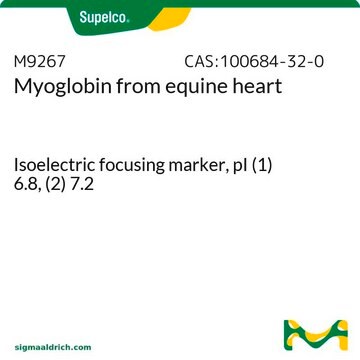C2867
Citocromo c from equine heart
BioUltra, ≥99% (SDS-PAGE), powder, suitable for mammalian cell culture
Sinónimos:
Citocromo c from horse heart
About This Item
Productos recomendados
biological source
horse heart
product line
BioUltra
assay
≥99% (SDS-PAGE)
form
powder
mol wt
12,384
storage condition
(Tightly closed Dry)
technique(s)
cell culture | mammalian: suitable
solubility
water: 10 mg/mL, dark red-brown
UniProt accession no.
storage temp.
−20°C
Gene Information
horse ... CYCS(100053958)
¿Está buscando productos similares? Visita Guía de comparación de productos
Categorías relacionadas
General description
Research area: Apoptosis
Application
Biochem/physiol Actions
Preparation Note
Other Notes
Storage Class
11 - Combustible Solids
wgk_germany
WGK 3
flash_point_f
Not applicable
flash_point_c
Not applicable
ppe
Eyeshields, Gloves, type N95 (US)
Certificados de análisis (COA)
Busque Certificados de análisis (COA) introduciendo el número de lote del producto. Los números de lote se encuentran en la etiqueta del producto después de las palabras «Lot» o «Batch»
¿Ya tiene este producto?
Encuentre la documentación para los productos que ha comprado recientemente en la Biblioteca de documentos.
Los clientes también vieron
Chromatograms
application for HPLCapplication for HPLCapplication for HPLCNuestro equipo de científicos tiene experiencia en todas las áreas de investigación: Ciencias de la vida, Ciencia de los materiales, Síntesis química, Cromatografía, Analítica y muchas otras.
Póngase en contacto con el Servicio técnico







